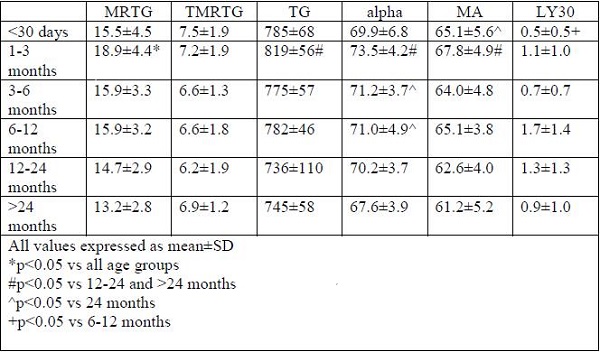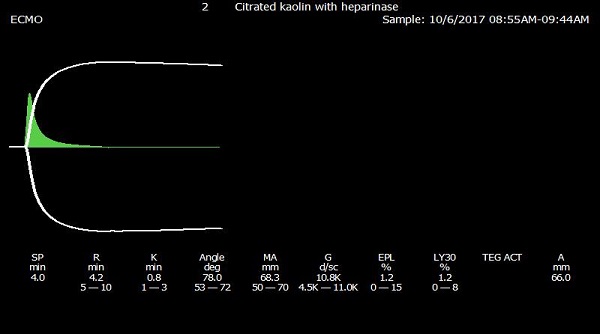CA-34
Baseline Thromboelastogram Derived Thrombin Generation Data in Children with Congenital Heart Defects
1Lilien M, 2Mackie D, 1Wilson E, 1Austin T, 1Guzzetta N, 1Miller B
1Emory University/Children's Healthcare of Atlanta, Atlanta, Georgia, USA; 2Georgia Institue of Technology, Atlanta, Georgia, USA
Introduction
Evaluation of thrombin generation provides a global assessment of coagulation that is more informative than focused laboratory tests. Thrombin generation can be quantified in vivo by measuring thrombin-antithrombin complexes or prothrombin fragments 1+2 or ex vivo by the calibrated automated thrombogram method (1). However, more timely results may be calculated from the first derivative of the thromboelastogram (TEG) tracing with the additional advantage of using whole blood so that the contribution of cellular blood elements to coagulation are considered (2). We have retrospectively evaluated routinely collected data to establish baseline thrombin generation values derived from TEG tracings in children.
Methods
Citrated whole blood samples were obtained after anesthetic induction in 25 patients in each of 6 age groups (<30 days, 1-3 months, 3-6 months, 6-12 months, 12-24 months, and >24 months). Kaolin and heparinase were added and TEG tracings were recorded using the TEG® 5000 Hemostasis System (Haemonetics) according to manufacturer’s instructions. Maximum rate of thrombin generation (MRTG), time to MRTG (TMRTG), and total thrombin (TG) were calculated by the manufacturer’s software from the derived velocity curve. Comparisons were made among age groups using ANOVA with post-hoc Tukey-Kramer analyses for normally-distributed data (MRTG, TMRTG, maximum amplitude [MA]) and using Kruskal-Wallis and Wilcoxon tests with Holm-Bonferroni adjustments for nonnormally-distributed data (TG, alpha, percent lysis 30 minutes after MA [LY30]).
Results
•Statistically higher MRTG and TG found in infants 1-3 months, especially compared to children 12-24 or >24 months,
•These differences were similar to those seen in TEG parameters, as expected
•Fibrinolysis was not delayed in 1-3 month old infants
Discussion
These data establish baseline parameters and demonstrate faster and greater quantity of thrombin generation in infants, most significantly those 1-3 months of age. Thus, either more thrombin is being formed or less is being disintegrated in infants. Since clot lysis was not delayed in these infants, they appear to generate more thrombin potentially due to quantitative deficiencies in physiologic anticoagulants (antithrombin, protein C and S) (3). This information may help us better manage clinical situations where clotting may have devastating effects, such as in infants dependent on shunts for pulmonary blood flow or on mechanical circulatory support devices.
1. Duarte et al. Rev Bras Hematol Hemoter 2017;39:259-65
2. Rivard et al. J Thromb Haemost 2005;3:2039-43
3. Andrew, Blood 1987;70:165-72
Top













